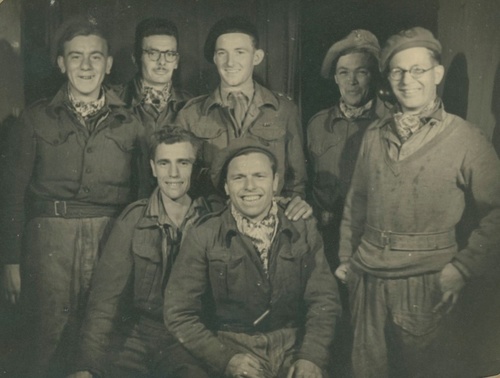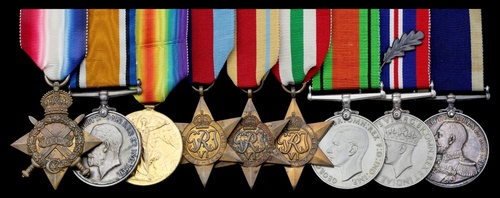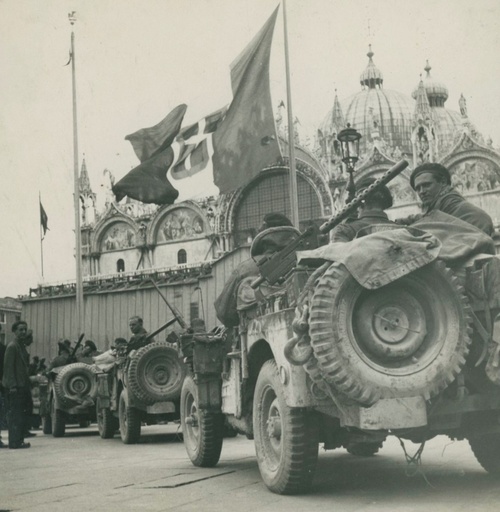Auction: 19002 - Orders, Decorations and Medals
Lot: 172
Sold by Order of a Direct Descendant
Family group:
The rare and historically important group of five awarded to Sapper L. S. Foweraker, Royal Engineers, one of the elite six-man 'Popski's Private Navy'
In April 1945, as the Allies advanced on Venice, this Clandestine unit transported Popski's Private Army (No. 1 Demolition Squadron) behind enemy lines to the Po Delta engaging in various covert and adventure-filled escapades, including landing Popski's troops in St. Mark's Square - Foweraker earned a 'mention' for his part in this remarkable episode - and recorded these events in a unique photographic archive
1939-45 Star; Africa Star, copy clasp, 1st Army; Italy Star; Defence and War Medals 1939-45, M.I.D. oak leaf, in original card box of issue addressed to 'L. S. Foweraker, 36 Woodstock Court, Lee, SE12', good very fine, with related riband bar
Four: Able Seaman S. E. Foreacre, Royal Navy
1915-15 Star (216860. S. E. Fareacre. A.B. R.N.); British War and Victory Medals (216860 S. E. Fareacre A.B. R.N.); Royal Navy L.S. & G.C. (216860. S. E. Foreacre, A.B. R.N.), note surname spelling, extremely fine, with related riband bar and original boxes of issue (9)
Lewis Sydney Foweraker was born on 26 September 1919, to a Methodist family living on Burnt Ash Hill, Eltham. After civilian employment as a clerk, he enlisted for National Service 'For the Duration of Emergency' at Curzon Street, Mayfair on 5 November 1939. His medical examination was held at Yorkshire Grey Dance Hall, Eltham Hill on 30 November 1939, and he was posted as a Sapper to No. 945 Inland Water Transport Company, Royal Engineers. This specialist unit undertook amphibious training in Scotland during 1940-42, Foweraker qualifying as a Lighterman Class III on 16 January 1942. His aptitude for piloting landing craft was to prove invaluable later in the war.
Foweraker's unit disembarked at Algiers on 13 November 1942, joining Lieutenant-General Armstrong's 1st Army as part of 'Operation Torch'. Following the German surrender at Tunis in May 1943, he served in Italy and was present at the liberation of Florence on 4 August 1944. In April 1945, as the Allies approached Venice, he was assigned to a six-man unit at Ravenna, led by Captain Brian 'Tommy' Thomas of the Royal Engineers.
Popski's Private Navy
Thomas had orders to commandeer five ramped cargo lighters, load them with Jeeps, and take them along the Adriatic coast from Ravenna to the Po Delta, behind German lines. The vessels were to link up with No. 1 Demolition Squadron, better known as 'Popski's Private Army'. Led by Major Vladimir Peniakoff, this legendary Special Forces unit was charged with liberating Venice via the Lagoon, thus avoiding (and outflanking) German positions along the River Po. Thomas' six-man team of Lightermen, responsible for safely conveying the P.P.A. to Venice, became 'Popski's Private Navy'. In his memoirs, Thomas recalled:
'Popski came up to me and said: "Brian, are you ready for the next move?" and I said: "Any time you like." And he said: "I have been in touch with the Canadian troops. They're going tomorrow morning at the north of Venice and we'll go in south by water."
The next morning we went off just after half past 6, just when it was daylight. We found that navigable canals were all marked by sticks, so instead of having to plod straight across unknown water, we did follow the staked out canals, right up between the Island of St. Giorgio and Venice itself across the grand canal to a point immediately at St. Mark's Square.
The thrill of this moment can never be told properly, because we were going to experience something that no other men had ever done and that is drive a vehicle around in St. Mark's Square. Popski went off first. Jean Caneri with me on board his jeep went off second and the whole Italian population of Venice seemed to be out in St. Mark's Square cheering us as we went round. It was a marvellous moment. I think probably the most marvellous moment of any of our Allies. Anyway we did that triumphant trip round, Popski went up one of the side alleys as far as he could in his jeep and met a Canadian officer coming down at the other way and exchanged greetings. There were a few snipers to pick up which they did and that was the end of it. I think Venice was very lucky to be saved without any real fighting going on.'
This remarkable scene is depicted in Foweraker's photograph album, sold as part of this Lot. There are images of cheering Venetian crowds, thronging around Popski's Jeeps (illustrated). There are several photographs of Foweraker (wearing glasses and a beret) in Venice with other members of Popski's Private Navy. Captain Brian Thomas died in July 2014, and his obituary in The Telegraph sheds further light on Venice's liberation. Popski's force returned to the vessels. Disembarking on the Lido, the P.P.A. continued to weaken German resolve with their raiding and sabotage operations.
Meanwhile, over the next 18 months, Popski's Private Navy was given responsibility over all shipping in the Venetian Lagoon, using the Island of St. Georgio as its Headquarters. Foweraker was 'mentioned' for his 'Gallant and Distinguished services in the Mediterranean theatre' (London Gazette 23 May 1946, refers). In July 1946 he was called to the Assembly Centre at Milan for his return to England, with these Medals sent to 36 Woodstock Court, Lee.
Sold together with an original archive comprising:
(i)
His unique photograph album, providing never-before-seen images of the Second World War, from his training in Scotland through to the liberation of Venice with Popski's Private Navy.
(ii)
Soldier's Service & Pay Book, Army Book 64, confirming entitlement, some wear due to age.
(iii)
Notice of his 'mention', issued by the Colonel in charge of Royal Engineer Records Office, Ditchling Road, Brighton, dated 16 July 1946.
(iv)
National Service (Armed Forces) Act 1939 summons for Medical Examination, dated 27 November 1939.
(v)
1963 Centenary Year Thames Sailing Barge Match gilt Medal.
Sidney Edwin Foreacre, the father of the above, was born at Lewisham, Kent on 13 December 1883. He joined H.M.S. Northampton as a Boy 2nd Class on 15 August 1901, transferring to Calliope on 26 October. He served aboard Swiftsure as an Able Seaman from 7 July 1906, and was aboard Mars at the outbreak of the Great War in August 1914. Having then served at various shore establishments and briefly aboard General Wolfe, he joined Erebus on 12 August 1916. Foreacre was aboard her on 28 October 1917, when she was damaged by a remote controlled German FL-boat suffering the loss of 50ft of anti-torpedo bulge. Leaving Erebus on 23 February 1919, he was discharged in June 1921. Returning to civilian life as a Postman, he was knocked off his bicycle and killed returning home from work in 1937; sold with a newspaper cutting and copied photograph of the recipient.
Subject to 20% VAT on Buyer’s Premium. For more information please view Terms and Conditions for Buyers.
Sold for
£8,000
Starting price
£2100









